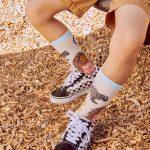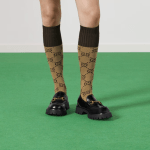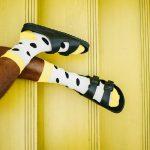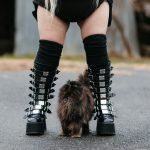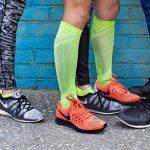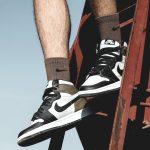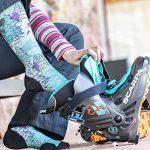Skiing Socks Size Guide for men, women and kids (with size charts)
Ski socks are more important than they appear to be, so we have to pay attention to what we wear. It might look like an exaggeration, but think about it, why do we wear socks? What factors affect our choices in pairs of socks? And more importantly, how do ski socks affect skiing? Let us break these things down one at a time. The importance of skiing socks size is explained in this guide.
Wearing 2 pairs of socks is the worst idea ever to adjust your fitting of ski boots.
A good sock for skiing is the first protection of our feet. Read on to know how to properly choose socks that fit your skiing equipment while efficiently keeping your feet warm. We cover everything about your ski socks; the right size, thickness, calf-length, airflow, performance fit, and much more.
The first line of protection for your feet is a sock. Socks prevent your footwear from rubbing and blisters from forming on your feet. When you go skiing, your feet are naturally exposed to cold temperatures and moisture, thanks to the snow. Skiing socks provide an ideal environment in the cold weather for your feet by maintaining a comfortable temperature and moisture around your feet.

Pieces of equipment used by skiers are boots, Socks, Gloves, Ski poles, Helmets, skis, and binding.
Size Chart For Length Of Stockings – ski socks
| Size Printed On Socks | Length Of Stockings (Inches) | Length Of Stockings (Cm) |
| Small | 11.8 | 30 |
| Medium | 13 | 33 |
| Large | 14 | 36 |
| X-Large | 15 | 38 |
Size Chart For Men’s Skiing Socks
| Shoe Size (US) | Shoe Size (UK) | Shoe Size (Euro) | Socks Length (Inches) | Socks Length (Cm) |
| 5-6 | 3-5.5 | 35-38 | 7-9 | 20-23 |
| 6-8.5 | 6-8 | 38-42 | 9-10 | 23-25 |
| 9-12 | 8.5-11.5 | 42-46 | 10-10.5 | 25-26 |
| 12-14 | 12-14 | 46-48 | 10.6-12 | 26-28 |
Size Chart For Women’s Skiing Socks
| Shoe Size (US) | Shoe Size (UK) | Shoe Size (Euro) | Socks Length (Inches) | Socks Length (Cm) |
| 4-6.5 | 2-4.5 | 35-37 | 8.2-9.3 | 21.0-23.5 |
| 7-9.5 | 5-7.5 | 38-41 | 9.4-10.4 | 24.0-26.5 |
| 10-12.5 | 8-11 | 42-44 | 10.5-11.8 | 27.0-30.0 |
Size Chart For Children’s Skiing Socks
| Shoe Size (US) | Shoe Size (UK) | Shoe Size (Euro) | Socks Length (Inches) | Socks Length (Cm) |
| 6C-8C | 5C-7C | 22-25 | 5.0-5.9 | 13.0-15.0 |
| 9C-11C | 8C-10C | 26-28 | 6.0-7.24 | 15.1-18.4 |
| 12C-2Y | 11C-2Y | 29-31 | 7.25-8.0 | 18.5-20.0 |
How To Measure Your Feet For Skiing Socks
How do i know my skiing sock size?
Skiing socks fabric can take the shape of any foot, therefore, foot length is all that matters. First of all you must realize that the numbers on all types of socks are not about the shoe size of the target owner of the socks, rather it is the length of the foot of the target owner of the socks. So in the US and UK, if you see the number “10” on a pair of skiing socks, it doesn’t mean that it is meant for people with shoe sizes 10. Rather, it means that it is meant for people whose feet are 10 inches long. 10 inches long feet are shoe sizes 8 in the US and 7.5 in the UK. Sometimes, the length may be shown in centimeters. So you should be ready to convert your measurements if need be. To know your feet’ length, all you need is a sheet of paper (A4 is good enough), a pencil or marker, and a ruler or measuring tape. Follow the simple steps below to know your feet’ length.
- Place sheet of paper on a smooth surface and place any of your feet on it.
- Using the pencil, make a dot right in front of your longest toe.
- Without moving your feet, make another dot right behind your heel.
- Remove your feet from the paper and measure the length between the two dots.
Discover a full article on how to measure your feet length properly
The measurements will be your new guide whenever you want to buy any pair of socks including skiing socks. If you already know your shoe size, just use the table below to try and find your suggested size for skiing socks. The length of the socks is the part that covers for feet, while the length of stockings is the part that covers your lower legs. Some people like their socks for skiing with little to no stockings, the type of socks that stop at the ankle. However, most skiing socks have lengthy stockings and some go as far as the knee joint and above. The sizes written on adult socks, regardless of gender usually have a common measurement.
How To Choose The Right Skiing Socks
The first defense against damage to your feet is the correct fitting of socks and ski boots. Blisters are created from areas of friction and are the result of your skin layers being pulled apart, especially due to a pair of cold feet. A single layer of fabric, such as a pair of socks, will significantly reduce the friction on your skin. Standard cotton socks are thinner sock that makes for good ultralight socks, but are not very odor resistant. They are lightweight sock that are popular with snowboard boots. If they get wet, they become uncomfortable for the advanced skier. Besides, in average conditions, they tend to give you cold feet.
Wool skiing socks
An option for a tough sock would be a wool sock. Wool sock is a thicker sock that tends to keep the foot warmer, but must always be shorter than the neck of every footwear you plan to wear for the entire day you plan to spend on skiing. Shall they get wet, they offer worse protection than the cotton pairs.
Synthetic Skiing socks
Winter socks made of synthetic materials are waterproof and can stretch to better-required lengths, however, due to their waterproof abilities, they can trap the moisture coming out of your feet and when worn for long periods of time might create a scenario of sweaty feet.
Merino wool skiing socks
Favorite models of wool ski socks among winter sports enthusiasts are usually high quality Merino wool. A 2-pack Merino wool sock is a medium-cushioned sock with great odor resistance and ankle protection element. Depending on the percentage of Merino wool, these winter ski socks have low wick moisture thereby maintain body temperature via great thermal insulation. Their amazing breathability makes them a pair of midweight socks as they maintain hot spots all over the feet. Some even have extra padding and extra moisture wicking. The best wool option is simply Merino wool
Compression Skiing socks
Modern advanced technology in clothing developments puts extra padding in socks to provide cushion for comfort in high-impact areas. Double layering of fabric within the sock will also help minimize the impact of external factors against the feet. Light padding and double-layer socks are commonly reserved for sport-specific uses. Your decision in a blend of fabrics has been made easier thanks to the manufacturers. The average skier usually buys a snowboard sock with a good enough performance fit. Your primary problem now would be in choosing the right size.
Ski socks sizes explained
Conclusion
Synthetic socks make better compression socks in cold conditions even in a poor boot liner. The average skier they have a high rating due to their benefits for the skier. They also make a good pair of calf socks for skiing. One can easily say that synthetic socks inside a good boot liner with a great boot fit are the best option. As for the right size, follow the steps and you will realize that things are easier than they seem.
Leave a comment behind and share the article with your skiing buddies.
Discover all skiing socks on Amazon
Related Sock size charts
- Falke Size Charts
- Kids Socks Size Chart by age: What are sock sizes for boys & girls
- Gucci Socks Size Charts for Adults and Kids
- Plus Size Socks Size Chart and Styling Guide for Men and Women
- Thigh High Socks Size Chart for Adults
- Compression Socks Size for Men and Women with Easy to Use Size-Charts
- Nike Socks Size and conversion (size charts included)
- Skiing Socks Size Guide for men, women and kids (with size charts)
- Adidas Socks Size Chart and conversion
- Sock Size Chart – The full sock fitting guide for men, women and kids


